Physical Address
304 North Cardinal St.
Dorchester Center, MA 02124
Buttock augmentation is major surgery, with the potential for significant complications.
The overall goal of buttock augmentation is to achieve a more youthful appearance and contour and to create the ideal waist-to-hip ratio of 0.7.
There are three acceptable methods of buttock augmentation: (1) silicone implants placed in the subfascial plane; (2) silicone implants placed in the intramuscular plane; and (3) autologous micro fat grafting.
Each method of buttock augmentation carries its own set of complications, risks, surgical equipment needs, and complications.
Preoperative planning and the surgical technique used should be patient-specific with regard to individual anatomy and patient desires.
Preoperative markings are crucial in guiding the surgical procedure and should be performed with the patient in a standing position.
![]()
![]() Access video and video lecture content for this chapter online at Elsevier eBooks+
Access video and video lecture content for this chapter online at Elsevier eBooks+
The attractiveness of the buttocks is not judged in isolation, but in proportion to the waist. According to Singh, there is one female body shape that men universally find most attractive (full buttocks, narrow waist). These ideal female proportions are summarized as a waist-to-hip ratio of 0.7 (measuring the waist at its narrowest and the buttock at the level of maximum circumference). In addition to this overall proportional relationship, there are various characteristics associated with attractive youthful buttocks. These include: (1) a smooth inward sweep of the lumbosacral area and waist; (2) a very feminine cleavage as the buttocks separate superiorly and inferiorly; (3) maximum prominence on the vertical axis at the level of the mid- to upper buttock, and on the transverse axis at the junction of the medial and central thirds of the buttocks; (4) minimal infragluteal crease; and (5) no ptosis.
Cuenca-Guerra and Lugo-Beltran identified four defining features that stood out as consistent features of beauty: (1) lateral depression formed by the lateral border of the gluteus maximus, the quadratus femoris, and the insertions of the gluteus medius and vastus lateralis to the greater trochanter; (2) infragluteal fold created by the ischial tuberosity, the insertions of the semitendinous muscle and long belly of the biceps femoris, and the lower border of the gluteus maximus; (3) supragluteal fossettes (one on either side), over the posterior superior iliac spine, created by the multifidus muscle, the lumbodorsal aponeurosis, and the insertion of the gluteus maximus; and (4) V-shaped crease, arising in the proximal portion of the gluteal crease.
A thorough grounding in anatomy and aesthetics is essential when dealing with the gluteal aesthetic unit.
The gluteus maximus muscle originates primarily along the lateral margin of the sacrum and, to a lesser extent, from coccyx and sacrotuberous ligament. The origin continues in an upward curvilinear fashion to the posterior iliac spine (identified as bilateral dimples in the parasacral zone); it only follows the crest for one-third of its initial distance. The superior limit of the gluteus maximus muscle is the posterior iliac spine. The gluteus maximus inserts into the iliotibial tract, and to a lesser degree, the greater trochanter ( Fig. 35.2.1 ).
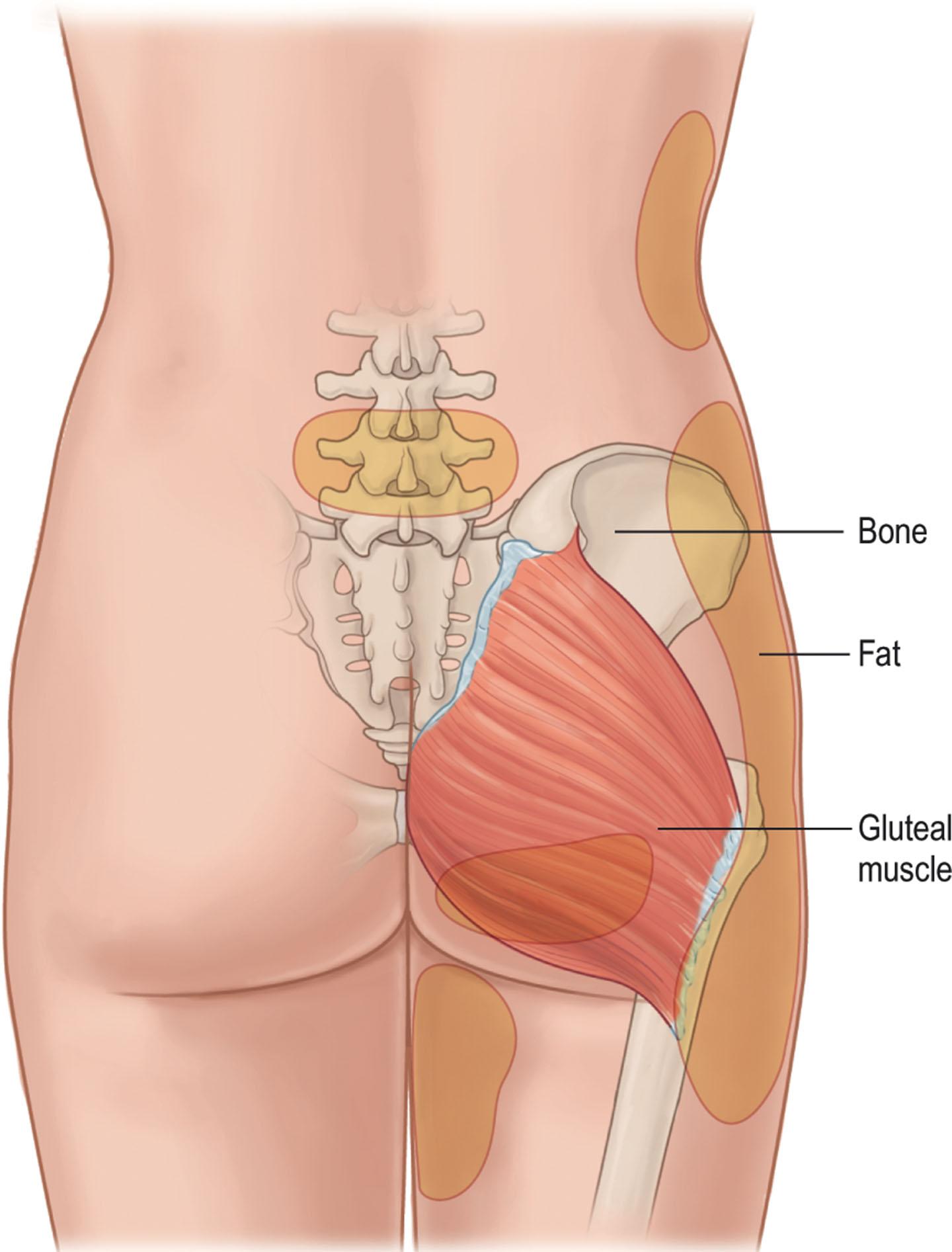
Knowledge of the superior aspect of the gluteus maximus origin is essential in describing the ideal buttock. However, buttock aesthetics are not solely dependent on the gluteus muscles; the overall buttock shape is also influenced by bony pelvic anatomy, fat distribution, and to a lesser degree, the tightness of skin. The skin will influence the appearance if there is laxity or ptosis, as is the case in massive weight loss patients. In fact, the attractiveness of the female buttock is primarily dependent on the thickness and distribution of the fatty layer, which is usually 50–60% of the volume of the buttock.
To evaluate the buttock, it is helpful to divide it into quadrants by drawing an imaginary line down the center of the buttock. The ideal buttock has equal volumes on either side of this line and has the shape of a football.
To further assess volume distribution, a horizontal mid-buttock line is added to divide the buttocks into four quadrants ( Fig. 35.2.2 ). The ideal buttock also has equal volume above and below this horizontal line. If we evaluate each quadrant individually, then the lower quadrants, three and four, are equal but tend to be slightly wider than one and two. In determining the best procedure for a particular patient, all four quadrants are evaluated as either sufficient or deficient.
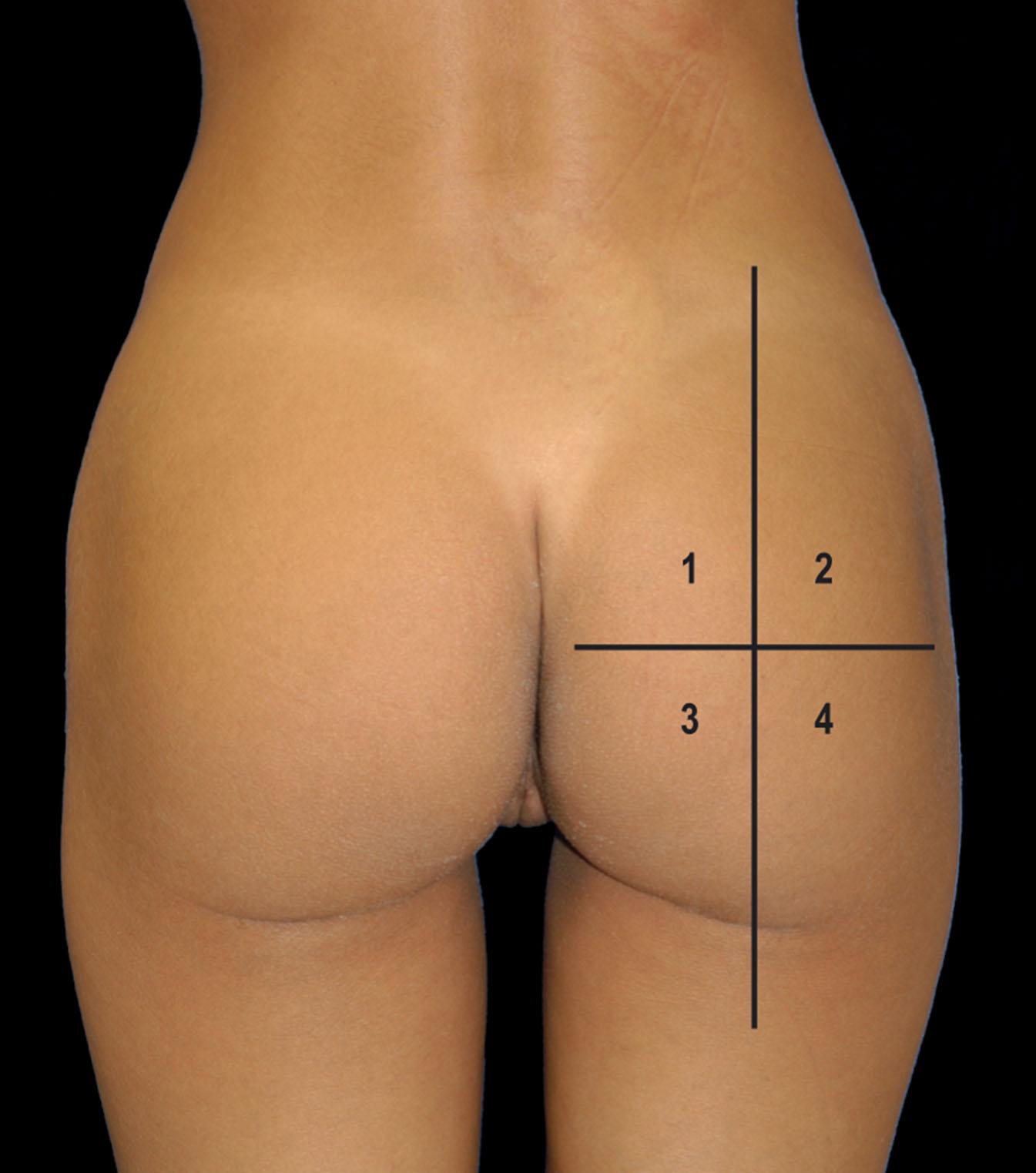
Once volume has been assessed, there are three other zones that surround the buttock, which become important in our evaluation: the upper inner gluteal/sacral junction; the lower inner gluteal fold/leg junction; and the mid-lateral gluteal/hip junction.
The inner gluteal/sacral space should be well defined so that a V-shape is apparent; this lower presacral space is appropriately called the “V” zone ( Fig. 35.2.3 ). As the “V” zone becomes more visible, the buttock has greater aesthetic appeal. In the ideal buttock, the gluteal muscle edge should be well defined and have a semicircular upward turn. If this space is not well defined, the buttock becomes blunt and appears flat, especially on the lateral view.
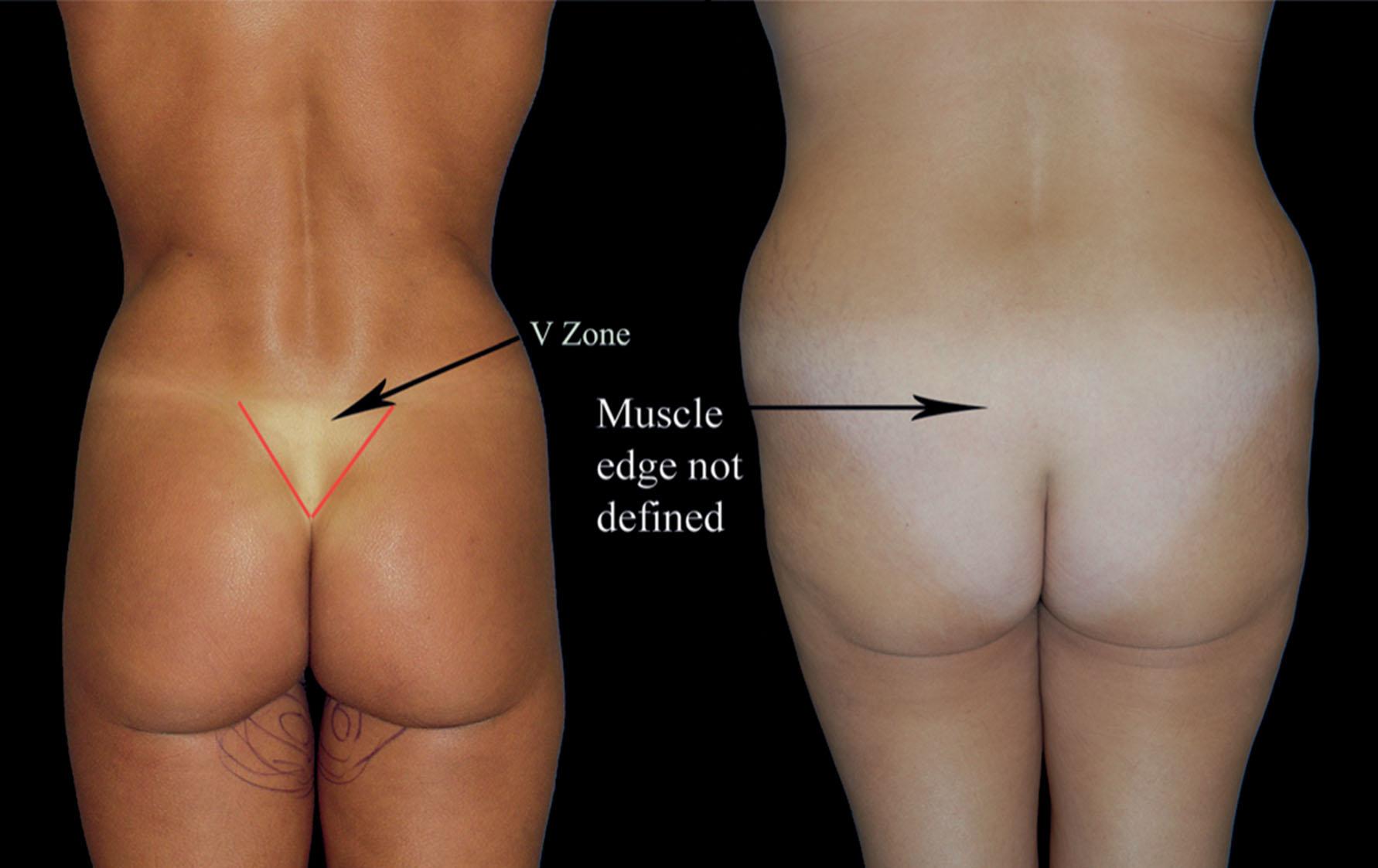
To describe this relationship, the intergluteal crease will be referred to as the midline. The upper aspect of the crease is easily identified; however, the inferior aspect is defined at the point where the buttock begins to separate from this midline. In the ideal buttock, this occurs at about the bottom two-thirds to three-quarters of the muscle. The separation widens until it meets the inner leg junction. At this point, the lower gluteal fold has a 45° take-off from the center intergluteal crease line and the inner gluteal fold/leg junction should create a diamond-shape space ( Fig. 35.2.4 ). This is a key point in gluteal aesthetics.
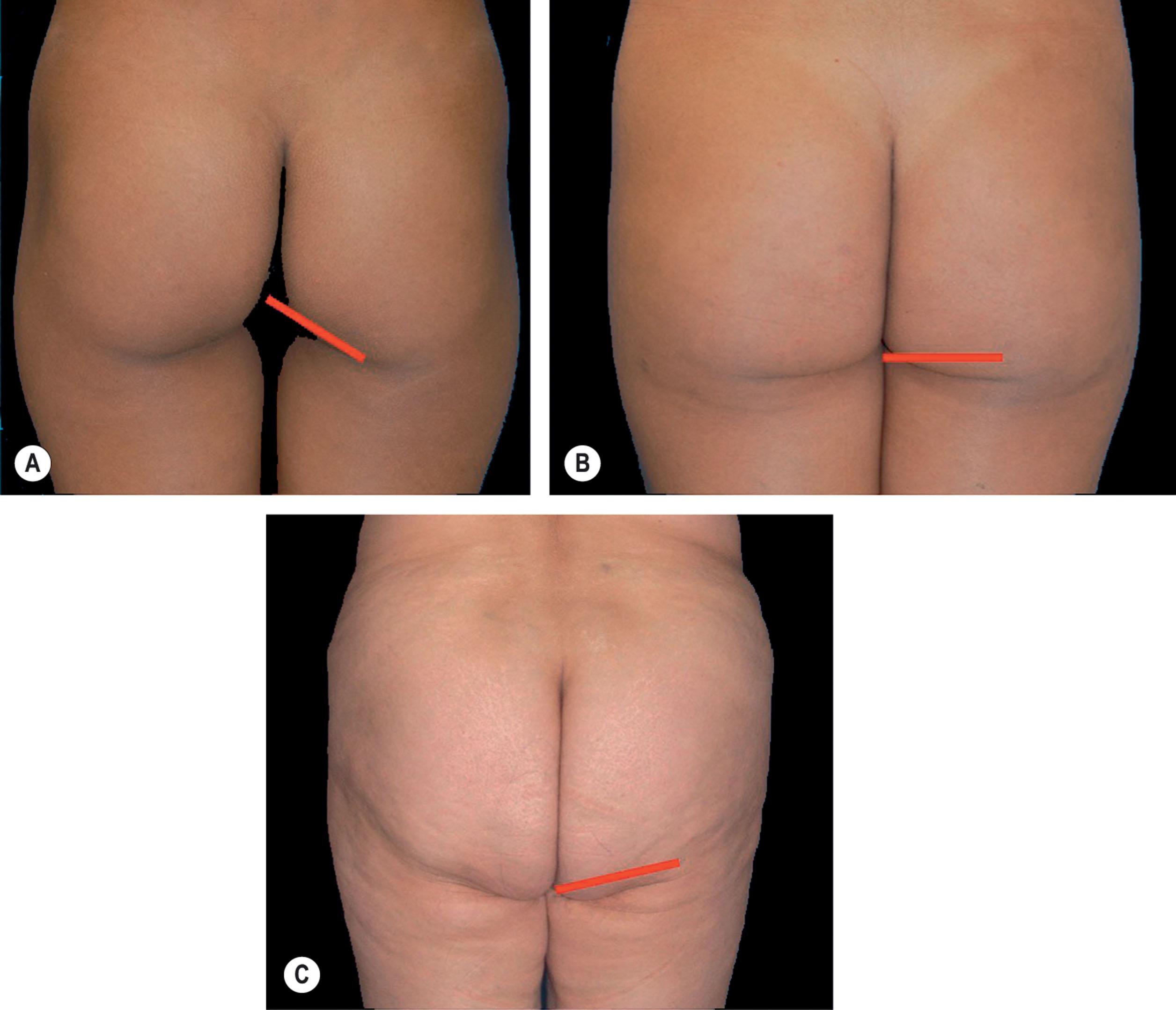
As the lower inner gluteal fold and inner leg become fuller, it changes the 45° sloping line to a more horizontal position, which causes the diamond-shape space to turn into a straight line, losing its aesthetic appeal (see Fig. 35.2.4 ). As the fullness increases, it develops an inverse relationship creating an upward slope (negative angle; see Fig. 35.2.4 ). Improvement of this zone will depend on the severity of the fullness.
In the aesthetic buttock, the lateral mid-buttock is an area without any depression. This zone is categorized as having no depression, mild depression, and moderate or severe depression ( Fig. 35.2.5 ).

On lateral view, the presacral area should have a sweeping curve that has a lazy “S” shape (from the back to the bottom of the gluteus; Fig. 35.2.6 ). Most of the gluteal volume is central and has equal distribution in the upper and lower gluteal zones, giving a C-shape curve. It has been suggested that the peak of the central mound should be at the level of the pubic bone ( Fig. 35.2.7 ).
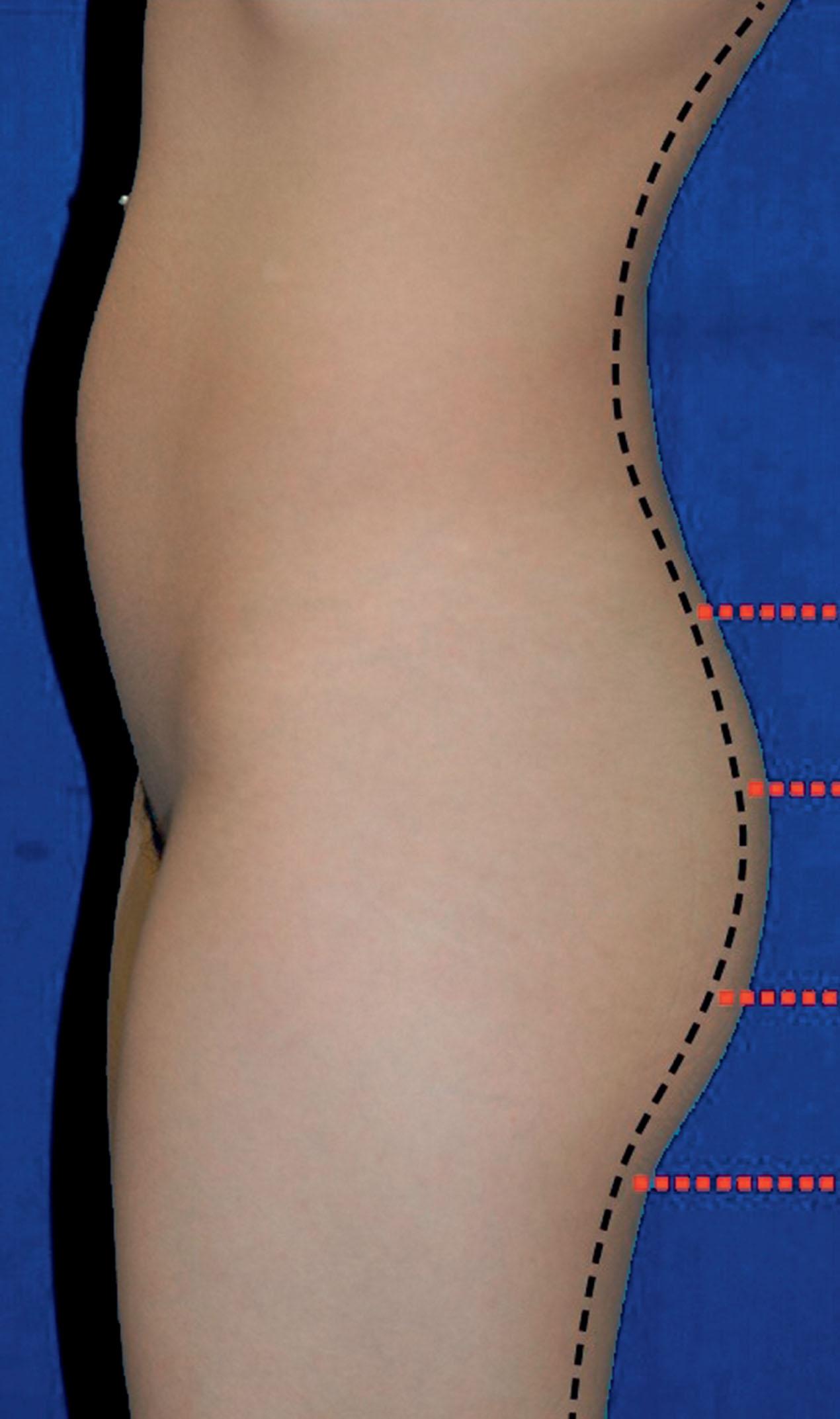
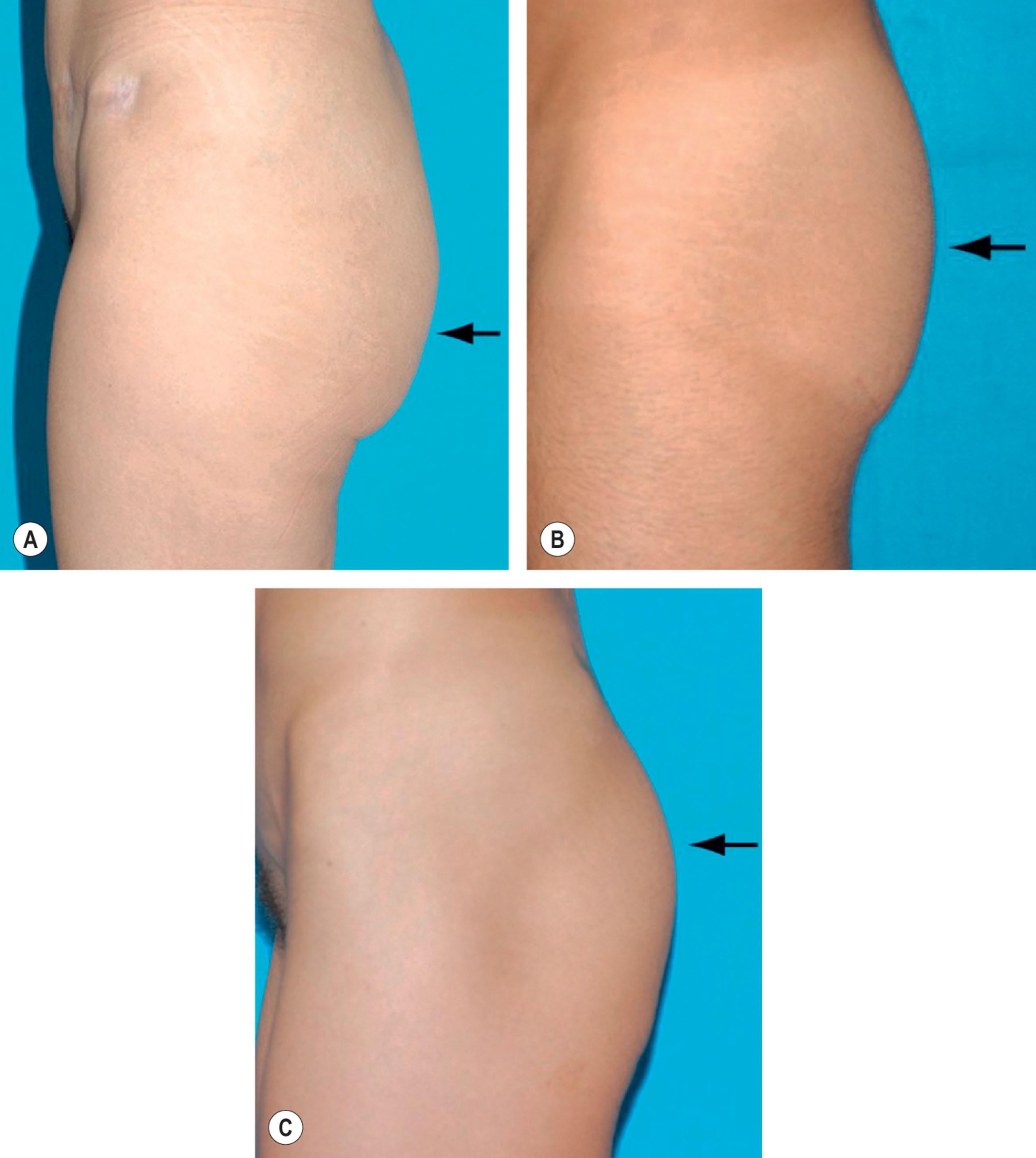
Determining where most of the volume lies (upper, central, or lower buttock) will be important in deciding what procedure is best used to augment the buttock ( Fig. 35.2.8 ).
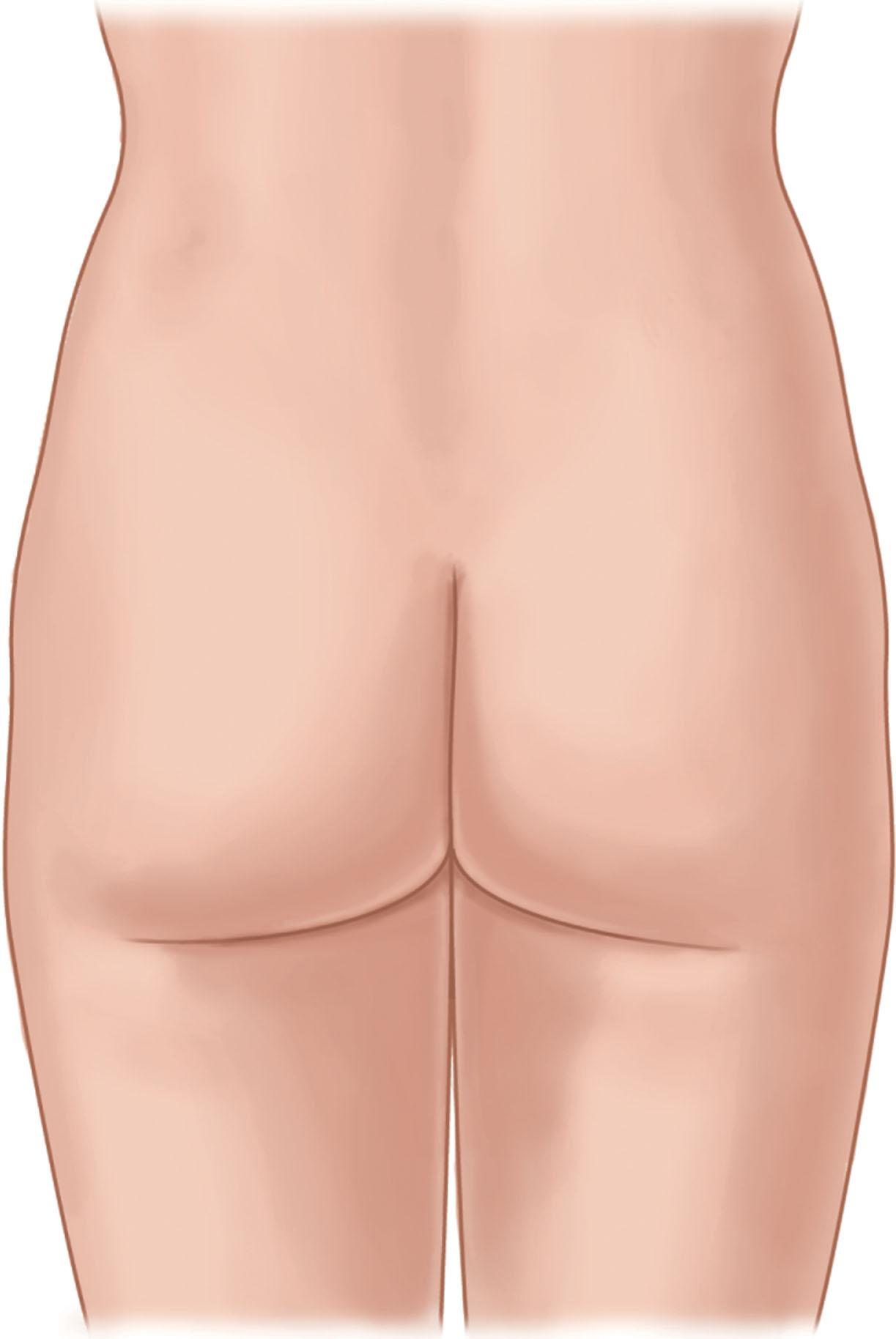
Patients present with a desire to improve their body contour/proportions, due to aging or general soft-tissue deficiency. Specific patient desires can be affected by ethnic background and social relationships. There are six zones where augmentation is requested: upper medial buttocks, mid-medial buttocks, lower medial buttocks, lateral hollow/trochanteric depression, lateral thigh, and various localized depressions.
Gluteal augmentation is not just about making the buttock bigger, but rather accentuating, contouring, and reshaping. Liposuction is for sculpting, while fat transfers and/or implants are used for volume expansion.
Ethnic ideals need to be taken into consideration regarding patient desires ( Table 35.2.1 ).
| Buttocks size | Lateral buttocks fullness | Lateral thigh fullness | |
|---|---|---|---|
| Asian | Small to moderate, but shapely | No | No |
| Caucasian | Full, but not extremely large | Rounded (voluptuous) or hollow (athletic) | No |
| Hispanic | Very full | Very full | Slight fullness |
| African American | As full as possible | Very full | Very full |
These patients generally want buttocks that are full but not extremely large. Fullness of the lateral thigh is an undesirable characteristic, but in regard to the lateral buttocks, Caucasians fall into two categories: some prefer more feminine, full, rounded buttocks, whereas others prefer flat or hollow lateral buttocks, which give a more athletic look. Neither of these two types of patients desire fullness in the lateral thigh.
These patients prefer buttocks and lateral buttocks that are very full and prefer a slight fullness in the lateral thigh. Compared with the much fuller lateral thighs requested by African Americans, Hispanic patients desire slight to moderate lateral thigh fullness. Usually Mexican patients show a lack of lumbar lordosis and need to add liposuction of this area to recreate it. Colombian patients show a defined lumbar lordosis with a thicker subcutaneous tissue.
These women have a strong and consistent ideal of very large buttocks. In addition, lumbar hyperlordosis is a desirable feature in addition to fullness of the upper buttocks. A full, prominent trochanteric area of the lateral thighs is desired and is still seen as a sign of fertility or fecundity. This lateral trochanteric area is uniquely called “the hip” among African Americans but most other cultures call the iliac crest “the hip”. African-American patients have large framed, and very full lateral thigh (hips), and usually request a significant enlargement of every area of the buttocks with as small a waist as possible. Another common request that is uniquely African-American is to create an extreme prominence of the upper buttocks (“shelf”; Fig. 35.2.9 ).
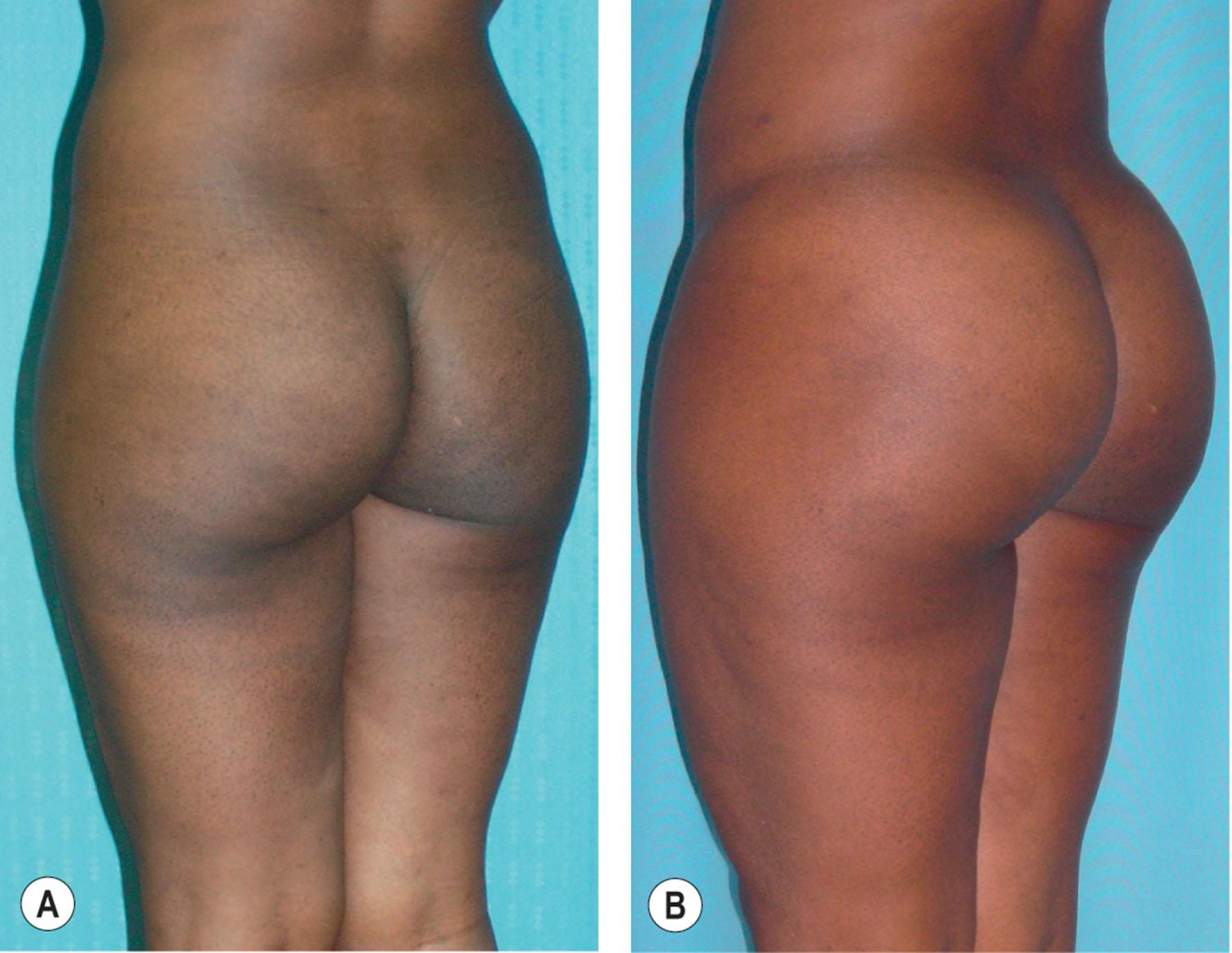
As Park et al . reported, in the Asian culture the aesthetic ideal is defined by an aggregate of the following four components: S-shaped curvature from lower back to buttocks, sufficient muscle volume, sufficient fat volume, and appropriate skin elasticity. The first two of these can be partially supplemented with physical activities such as stretching and yoga. However, the latter two components cannot be altered without surgical interventions. In this regard, the goal of gluteal augmentation was to restore aesthetic back curvature, provide sufficient hip volume (projection), and reposition the point of maximal gluteal projection to be higher than the pubic hair.
These patients prefer small to moderate-size buttocks, and fullness in the lateral buttocks or lateral thigh is almost never desired. Moreover, the shape of the buttocks and its relative proportion to the overall body frame is very important to this ethnic group. They are usually shorter and smaller than other ethnic groups, so even small changes in size or shape of the buttocks can have dramatic results.
The ideal patients for implants are young, with an athletic build with little or no ptosis. Morbidly obese patients are not candidates for this surgery unless they lose weight, after which the laxity of tissues converts them into good candidates if they undergo excisional procedures to correct the back and gluteal regions.
Singh has documented the importance of an ideal waist-to-hip ratio of 0.7. There is a tremendous synergistic effect of liposuction of the lower back, waist, and flanks in conjunction with buttock augmentation to achieve this ideal waist-to-hip ratio. This is clearly evidenced by the fact that fuller, more shapely buttocks appear more attractive when the waist is slender rather than fuller.
In attractive female buttocks, there is beautiful cleavage as the buttocks separate superiorly. Furthermore, there is an inward sweep of the lower back, lumbar, and sacral area, which accentuates this cleavage. It is also important to make the buttocks shorter vertically. A short, full buttock is attractive. A vertically long buttock simply appears big.
The enhancement of buttock volume with silicone gluteal implants has rapidly gained in popularity over the past decade. For many leaner patients, gluteal augmentation with autologous fat grafting is not an option secondary to the lack of donor tissue. In those patients, gluteal augmentation with silicone implants is the only remaining option to increase buttock volume. According to the of Society of Plastic Surgeons, 1149 buttock augmentation with implants were performed in 2011 by member surgeons, up from 542 procedures performed in 2005, the first year with recorded data for this procedure.
There are three main issues that need to be decided when selecting implants: implant location, shape, and size. The implant content can be a solid silicone elastomer or silicone cohesive gel. In a multicenter survey, Mofid et al . showed that the majority of surgeons (63.2%) used textured implants.
In 1984, Robles described the submuscular approach. This approach preserves the aponeurotic system that holds gluteal skin in position and has the advantage of reducing the formation of capsular contracture. However, it introduced a new anatomic problem with the potential risk of injury to the sciatic nerve. This is the largest peripheral nerve in the body, emerging from the pelvis via the greater sciatic foramen, entering the surgical plane below the bottom edge superiorly and laterally around the ischial tuberosity. As the dissection of the submuscular plane is carried inferiorly, the sciatic nerve can be injured. Even if the nerve is not injured during dissection, if the lower edge of the implant extends below the mid-buttock, it will be resting on the nerve and may cause symptoms. The submuscular position also has the disadvantage of being a small space and therefore limits the use of large implants. Consequently, implants should rarely be placed in this submuscular plane.
Become a Clinical Tree membership for Full access and enjoy Unlimited articles
If you are a member. Log in here